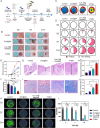Construction of programmed time-released multifunctional hydrogel with antibacterial and anti-inflammatory properties for impaired wound healing
- PMID: 38519957
- PMCID: PMC10960406
- DOI: 10.1186/s12951-024-02390-y
Construction of programmed time-released multifunctional hydrogel with antibacterial and anti-inflammatory properties for impaired wound healing
Abstract
The successful reprogramming of impaired wound healing presents ongoing challenges due to the impaired tissue microenvironment caused by severe bacterial infection, excessive oxidative stress, as well as the inappropriate dosage timing during different stages of the healing process. Herein, a dual-layer hydrogel with sodium alginate (SA)-loaded zinc oxide (ZnO) nanoparticles and poly(N-isopropylacrylamide) (PNIPAM)-loaded Cu5.4O ultrasmall nanozymes (named programmed time-released multifunctional hydrogel, PTMH) was designed to dynamically regulate the wound inflammatory microenvironment based on different phases of wound repairing. PTMH combated bacteria at the early phase of infection by generating reactive oxygen species through ZnO under visible-light irradiation with gradual degradation of the lower layer. Subsequently, when the upper layer was in direct contact with the wound tissue, Cu5.4O ultrasmall nanozymes were released to scavenge excessive reactive oxygen species. This neutralized a range of inflammatory factors and facilitated the transition from the inflammatory phase to the proliferative phase. Furthermore, the utilization of Cu5.4O ultrasmall nanozymes enhanced angiogenesis, thereby facilitating the delivery of oxygen and nutrients to the impaired tissue. Our experimental findings indicate that PTMHs promote the healing process of diabetic wounds with bacterial infection in mice, exhibiting notable antibacterial and anti-inflammatory properties over a specific period of time.
Keywords: Anti-inflammation; Antibacterial; Nanozymes; Time-released hydrogel; Wound healing.
© 2024. The Author(s).
Conflict of interest statement
The authors declare that they have no known competing financial interests or personal relationships that could have appeared to influence the work reported in this paper.
Figures







Similar articles
-
Construction of heparin-based hydrogel incorporated with Cu5.4O ultrasmall nanozymes for wound healing and inflammation inhibition.Bioact Mater. 2021 Mar 9;6(10):3109-3124. doi: 10.1016/j.bioactmat.2021.02.006. eCollection 2021 Oct. Bioact Mater. 2021. PMID: 33778192 Free PMC article.
-
Ultrasmall Antioxidant Copper Nanozyme to Enhance Stem Cell Microenvironment for Promoting Diabetic Wound Healing.Int J Nanomedicine. 2024 Dec 19;19:13563-13578. doi: 10.2147/IJN.S487647. eCollection 2024. Int J Nanomedicine. 2024. PMID: 39720217 Free PMC article.
-
Multifunctional hydrogel with reactive oxygen species scavenging and photothermal antibacterial activity accelerates infected diabetic wound healing.Acta Biomater. 2023 Jan 1;155:199-217. doi: 10.1016/j.actbio.2022.11.023. Epub 2022 Nov 17. Acta Biomater. 2023. PMID: 36402298
-
Multifunctional and theranostic hydrogels for wound healing acceleration: An emphasis on diabetic-related chronic wounds.Environ Res. 2023 Dec 1;238(Pt 1):117087. doi: 10.1016/j.envres.2023.117087. Epub 2023 Sep 15. Environ Res. 2023. PMID: 37716390 Review.
-
Emerging antibacterial nanozymes for wound healing.Smart Med. 2023 Feb 19;2(3):e20220025. doi: 10.1002/SMMD.20220025. eCollection 2023 Aug. Smart Med. 2023. PMID: 39188347 Free PMC article. Review.
Cited by
-
Smart Poly(N-isopropylacrylamide)-Based Hydrogels: A Tour D'horizon of Biomedical Applications.Gels. 2025 Mar 15;11(3):207. doi: 10.3390/gels11030207. Gels. 2025. PMID: 40136912 Free PMC article. Review.
-
Research Progress of Multifunctional Hydrogels in Promoting Wound Healing of Diabetes.Int J Nanomedicine. 2025 Jun 16;20:7549-7578. doi: 10.2147/IJN.S519100. eCollection 2025. Int J Nanomedicine. 2025. PMID: 40546804 Free PMC article. Review.
-
Design of nano mume Fructus charcoal by reshaping inflammatory microenvironment as biofunctional wound nanomedicine.Mater Today Bio. 2025 Jun 9;33:101971. doi: 10.1016/j.mtbio.2025.101971. eCollection 2025 Aug. Mater Today Bio. 2025. PMID: 40585036 Free PMC article.
-
Advancing diabetic wound care: The role of copper-containing hydrogels.Heliyon. 2024 Sep 26;10(20):e38481. doi: 10.1016/j.heliyon.2024.e38481. eCollection 2024 Oct 30. Heliyon. 2024. PMID: 39640763 Free PMC article. Review.
References
-
- Maschalidi S, Mehrotra P, Keceli BN, De Cleene HKL, Lecomte K, Van der Cruyssen R, Janssen P, Pinney J, van Loo G, Elewaut D, Massie A, Hoste E, Ravichandran KS. Targeting SLC7A11 improves efferocytosis by dendritic cells and wound healing in diabetes. Nature. 2022;606(7915):776–84. doi: 10.1038/s41586-022-04754-6. - DOI - PubMed
MeSH terms
Substances
Grants and funding
- SKLKF202208/State Key Laboratory of Trauma, Burns and Combined Injury
- SKLKF202208/State Key Laboratory of Trauma, Burns and Combined Injury
- SKLKF202208/State Key Laboratory of Trauma, Burns and Combined Injury
- 82372514/National Natural Science Foundation of China
- 82372514/National Natural Science Foundation of China
LinkOut - more resources
Full Text Sources
Medical

